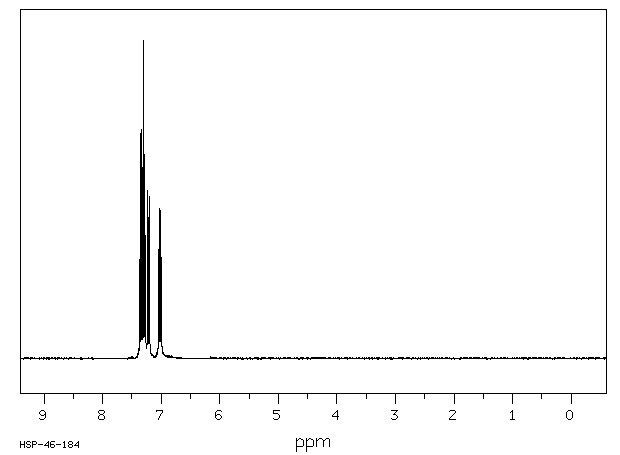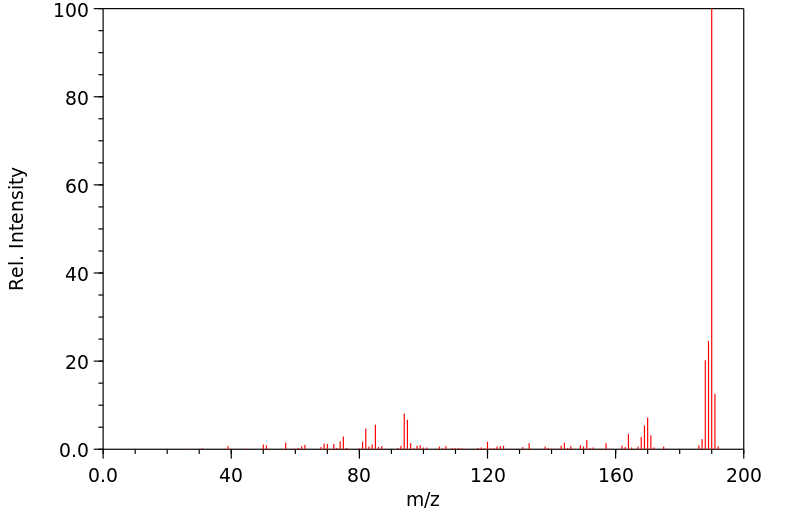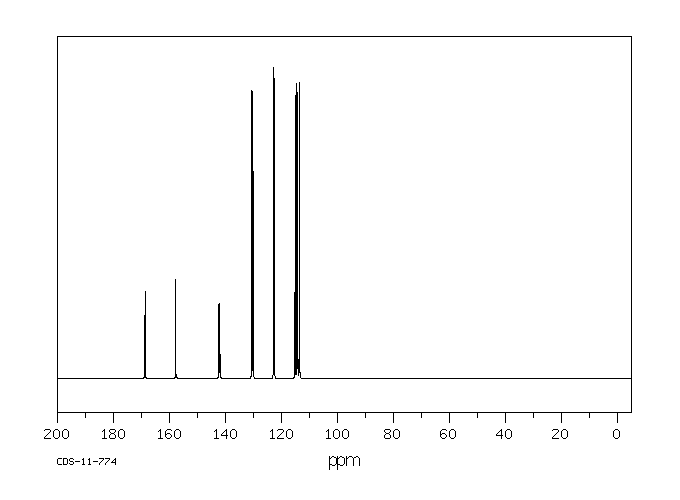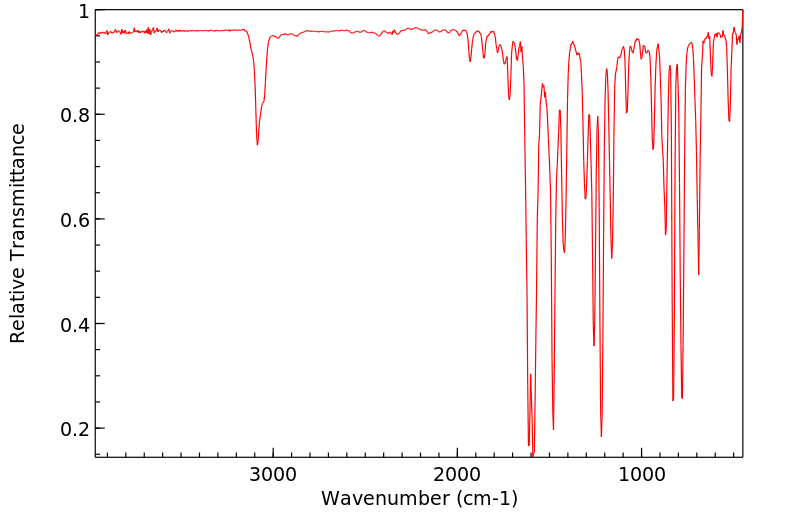3,3'-二氟联苯 | 396-64-5
中文名称
3,3'-二氟联苯
中文别名
3,3'-二氟联苯,97;3,3"-二氟联苯;3,3"-二氟联苯,97%;3,3'-二氟联苯,97%
英文名称
3,3'-difluoro-biphenyl
英文别名
3,3'-difluoro-1,1'-biphenyl;3,3′-difluorobiphenyl;1-fluoro-3-(3-fluorophenyl)benzene
CAS
396-64-5
化学式
C12H8F2
mdl
MFCD00039216
分子量
190.192
InChiKey
GAYJHUJLHJWCTH-UHFFFAOYSA-N
BEILSTEIN
——
EINECS
——
-
物化性质
-
计算性质
-
ADMET
-
安全信息
-
SDS
-
制备方法与用途
-
上下游信息
-
文献信息
-
表征谱图
-
同类化合物
-
相关功能分类
-
相关结构分类
物化性质
-
熔点:7-8°C
-
沸点:130 °C
-
密度:1,21 g/cm3
-
闪点:130°C/14mm
-
溶解度:难溶于水
计算性质
-
辛醇/水分配系数(LogP):3.7
-
重原子数:14
-
可旋转键数:1
-
环数:2.0
-
sp3杂化的碳原子比例:0.0
-
拓扑面积:0
-
氢给体数:0
-
氢受体数:2
安全信息
-
危险等级:9
-
危险品标志:Xi
-
安全说明:S26,S36
-
危险类别码:R36/37/38
-
海关编码:2903999090
-
包装等级:II
-
危险类别:9
-
危险品运输编号:3151
-
危险性防范说明:P264,P280,P302+P352+P332+P313+P362+P364,P305+P351+P338+P337+P313
-
危险性描述:H315,H319
-
储存条件:室温
SDS
3,3'-二氟联苯 修改号码:2
模块 1. 化学品
产品名称: 3,3'-Difluorobiphenyl
修改号码: 2
模块 2. 危险性概述
GHS分类
物理性危害 未分类
健康危害
皮肤腐蚀/刺激 第2级
严重损伤/刺激眼睛 2A类
环境危害 未分类
GHS标签元素
图标或危害标志
信号词 警告
危险描述 造成皮肤刺激
造成严重眼刺激
防范说明
[预防] 处理后要彻底清洗双手。
穿戴防护手套/护目镜/防护面具。
[急救措施] 眼睛接触:用水小心清洗几分钟。如果方便,易操作,摘除隐形眼镜。继续冲洗。
眼睛接触:求医/就诊
皮肤接触:用大量肥皂和水轻轻洗。
若皮肤刺激:求医/就诊。
脱掉被污染的衣物,清洗后方可重新使用。
模块 3. 成分/组成信息
单一物质/混和物 单一物质
化学名(中文名): 3,3'-二氟联苯
百分比: >96.0%(GC)
CAS编码: 396-64-5
分子式: C12H8F2
3,3'-二氟联苯 修改号码:2
模块 4. 急救措施
吸入: 将受害者移到新鲜空气处,保持呼吸通畅,休息。若感不适请求医/就诊。
皮肤接触: 立即去除/脱掉所有被污染的衣物。用大量肥皂和水轻轻洗。
若皮肤刺激或发生皮疹:求医/就诊。
眼睛接触: 用水小心清洗几分钟。如果方便,易操作,摘除隐形眼镜。继续清洗。
如果眼睛刺激:求医/就诊。
食入: 若感不适,求医/就诊。漱口。
紧急救助者的防护: 救援者需要穿戴个人防护用品,比如橡胶手套和气密性护目镜。
模块 5. 消防措施
合适的灭火剂: 干粉,泡沫,雾状水,二氧化碳
不适用的灭火剂: 棒状水
特殊危险性: 小心,燃烧或高温下可能分解产生毒烟。
特定方法: 从上风处灭火,根据周围环境选择合适的灭火方法。
非相关人员应该撤离至安全地方。
周围一旦着火:如果安全,移去可移动容器。
消防员的特殊防护用具: 灭火时,一定要穿戴个人防护用品。
模块 6. 泄漏应急处理
个人防护措施,防护用具, 使用个人防护用品。远离溢出物/泄露处并处在上风处。确保足够通风。
紧急措施: 泄露区应该用安全带等圈起来,控制非相关人员进入。
环保措施: 防止进入下水道。
控制和清洗的方法和材料: 用合适的吸收剂(如:旧布,干砂,土,锯屑)吸收泄漏物。一旦大量泄漏,筑堤控
制。附着物或收集物应该立即根据合适的法律法规废弃处置。
模块 7. 操作处置与储存
处理
技术措施: 在通风良好处进行处理。穿戴合适的防护用具。防止烟雾产生。处理后彻底清洗双手
和脸。
注意事项: 如果蒸气或浮质产生,使用通风、局部排气。
操作处置注意事项: 避免接触皮肤、眼睛和衣物。
贮存
储存条件: 保持容器密闭。存放于凉爽、阴暗处。
远离不相容的材料比如氧化剂存放。
包装材料: 依据法律。
模块 8. 接触控制和个体防护
工程控制: 尽可能安装封闭体系或局部排风系统,操作人员切勿直接接触。同时安装淋浴器和洗
眼器。
个人防护用品
呼吸系统防护: 防毒面具。依据当地和政府法规。
手部防护: 防护手套。
眼睛防护: 安全防护镜。如果情况需要,佩戴面具。
皮肤和身体防护: 防护服。如果情况需要,穿戴防护靴。
模块 9. 理化特性
液体
外形(20°C):
外观: 透明
颜色: 无色-浅黄色
气味: 无资料
3,3'-二氟联苯 修改号码:2
模块 9. 理化特性
pH: 无数据资料
熔点: 6°C (凝固点)
沸点/沸程 130 °C/1.9kPa
闪点: 无资料
爆炸特性
爆炸下限: 无资料
爆炸上限: 无资料
密度: 1.21
溶解度: 无资料
模块 10. 稳定性和反应性
稳定性: 一般情况下稳定。
反应性: 未报道特殊反应性。
须避免接触的物质 氧化剂
危险的分解产物: 一氧化碳, 二氧化碳, 氟化氢
模块 11. 毒理学信息
急性毒性: 无资料
对皮肤腐蚀或刺激: 无资料
对眼睛严重损害或刺激: 无资料
生殖细胞变异原性: 无资料
致癌性:
IARC = 无资料
NTP = 无资料
生殖毒性: 无资料
模块 12. 生态学信息
生态毒性:
鱼类: 无资料
甲壳类: 无资料
藻类: 无资料
残留性 / 降解性: 无资料
潜在生物累积 (BCF): 无资料
土壤中移动性
log水分配系数: 无资料
土壤吸收系数 (Koc): 无资料
亨利定律 无资料
constaNT(PaM3/mol):
模块 13. 废弃处置
如果可能,回收处理。请咨询当地管理部门。建议在装有后燃和洗涤装置的化学焚烧炉中焚烧。废弃处置时请遵守
国家、地区和当地的所有法规。
模块 14. 运输信息
联合国分类: 第9类 杂类
UN编号: 3151
包装等级: II
海洋污染物: Y
3,3'-二氟联苯 修改号码:2
模块 15. 法规信息
《危险化学品安全管理条例》(2002年1月26日国务院发布): 针对危险化学品的安全使用、生产、储存、运输、装
卸等方面均作了相应的规定。
模块16 - 其他信息
N/A
模块 1. 化学品
产品名称: 3,3'-Difluorobiphenyl
修改号码: 2
模块 2. 危险性概述
GHS分类
物理性危害 未分类
健康危害
皮肤腐蚀/刺激 第2级
严重损伤/刺激眼睛 2A类
环境危害 未分类
GHS标签元素
图标或危害标志
信号词 警告
危险描述 造成皮肤刺激
造成严重眼刺激
防范说明
[预防] 处理后要彻底清洗双手。
穿戴防护手套/护目镜/防护面具。
[急救措施] 眼睛接触:用水小心清洗几分钟。如果方便,易操作,摘除隐形眼镜。继续冲洗。
眼睛接触:求医/就诊
皮肤接触:用大量肥皂和水轻轻洗。
若皮肤刺激:求医/就诊。
脱掉被污染的衣物,清洗后方可重新使用。
模块 3. 成分/组成信息
单一物质/混和物 单一物质
化学名(中文名): 3,3'-二氟联苯
百分比: >96.0%(GC)
CAS编码: 396-64-5
分子式: C12H8F2
3,3'-二氟联苯 修改号码:2
模块 4. 急救措施
吸入: 将受害者移到新鲜空气处,保持呼吸通畅,休息。若感不适请求医/就诊。
皮肤接触: 立即去除/脱掉所有被污染的衣物。用大量肥皂和水轻轻洗。
若皮肤刺激或发生皮疹:求医/就诊。
眼睛接触: 用水小心清洗几分钟。如果方便,易操作,摘除隐形眼镜。继续清洗。
如果眼睛刺激:求医/就诊。
食入: 若感不适,求医/就诊。漱口。
紧急救助者的防护: 救援者需要穿戴个人防护用品,比如橡胶手套和气密性护目镜。
模块 5. 消防措施
合适的灭火剂: 干粉,泡沫,雾状水,二氧化碳
不适用的灭火剂: 棒状水
特殊危险性: 小心,燃烧或高温下可能分解产生毒烟。
特定方法: 从上风处灭火,根据周围环境选择合适的灭火方法。
非相关人员应该撤离至安全地方。
周围一旦着火:如果安全,移去可移动容器。
消防员的特殊防护用具: 灭火时,一定要穿戴个人防护用品。
模块 6. 泄漏应急处理
个人防护措施,防护用具, 使用个人防护用品。远离溢出物/泄露处并处在上风处。确保足够通风。
紧急措施: 泄露区应该用安全带等圈起来,控制非相关人员进入。
环保措施: 防止进入下水道。
控制和清洗的方法和材料: 用合适的吸收剂(如:旧布,干砂,土,锯屑)吸收泄漏物。一旦大量泄漏,筑堤控
制。附着物或收集物应该立即根据合适的法律法规废弃处置。
模块 7. 操作处置与储存
处理
技术措施: 在通风良好处进行处理。穿戴合适的防护用具。防止烟雾产生。处理后彻底清洗双手
和脸。
注意事项: 如果蒸气或浮质产生,使用通风、局部排气。
操作处置注意事项: 避免接触皮肤、眼睛和衣物。
贮存
储存条件: 保持容器密闭。存放于凉爽、阴暗处。
远离不相容的材料比如氧化剂存放。
包装材料: 依据法律。
模块 8. 接触控制和个体防护
工程控制: 尽可能安装封闭体系或局部排风系统,操作人员切勿直接接触。同时安装淋浴器和洗
眼器。
个人防护用品
呼吸系统防护: 防毒面具。依据当地和政府法规。
手部防护: 防护手套。
眼睛防护: 安全防护镜。如果情况需要,佩戴面具。
皮肤和身体防护: 防护服。如果情况需要,穿戴防护靴。
模块 9. 理化特性
液体
外形(20°C):
外观: 透明
颜色: 无色-浅黄色
气味: 无资料
3,3'-二氟联苯 修改号码:2
模块 9. 理化特性
pH: 无数据资料
熔点: 6°C (凝固点)
沸点/沸程 130 °C/1.9kPa
闪点: 无资料
爆炸特性
爆炸下限: 无资料
爆炸上限: 无资料
密度: 1.21
溶解度: 无资料
模块 10. 稳定性和反应性
稳定性: 一般情况下稳定。
反应性: 未报道特殊反应性。
须避免接触的物质 氧化剂
危险的分解产物: 一氧化碳, 二氧化碳, 氟化氢
模块 11. 毒理学信息
急性毒性: 无资料
对皮肤腐蚀或刺激: 无资料
对眼睛严重损害或刺激: 无资料
生殖细胞变异原性: 无资料
致癌性:
IARC = 无资料
NTP = 无资料
生殖毒性: 无资料
模块 12. 生态学信息
生态毒性:
鱼类: 无资料
甲壳类: 无资料
藻类: 无资料
残留性 / 降解性: 无资料
潜在生物累积 (BCF): 无资料
土壤中移动性
log水分配系数: 无资料
土壤吸收系数 (Koc): 无资料
亨利定律 无资料
constaNT(PaM3/mol):
模块 13. 废弃处置
如果可能,回收处理。请咨询当地管理部门。建议在装有后燃和洗涤装置的化学焚烧炉中焚烧。废弃处置时请遵守
国家、地区和当地的所有法规。
模块 14. 运输信息
联合国分类: 第9类 杂类
UN编号: 3151
包装等级: II
海洋污染物: Y
3,3'-二氟联苯 修改号码:2
模块 15. 法规信息
《危险化学品安全管理条例》(2002年1月26日国务院发布): 针对危险化学品的安全使用、生产、储存、运输、装
卸等方面均作了相应的规定。
模块16 - 其他信息
N/A
反应信息
-
作为反应物:描述:参考文献:名称:Metal-ammonia reduction of fluorinated aromatic compounds摘要:DOI:10.1021/jo00435a018
-
作为产物:描述:参考文献:名称:钯纳米颗粒包覆的金属有机骨架催化 Suzuki 均偶联反应合成联芳基化合物摘要:摘要 Suzuki 均偶联反应极大地加速了苯基硼酸的非均相偶联反应。在这项工作中,设计了一种串联路线,首先一部分苯基硼酸与碘反应生成碘苯,然后另一部分苯基硼酸与碘苯偶联生成联芳基化合物。串联反应由包封有钯纳米颗粒(Pd@MOFs)的金属有机骨架的双功能多相催化剂催化。这种在苯环之间形成对称CC键的策略具有效率高、易于分离、可回收性好、不添加有毒卤代苯等明显优点。DOI:10.1016/j.inoche.2020.108368
-
作为试剂:描述:ethyl 4-(3-fluorophenyl)butanoate 、 sodium hydroxide 在 hexanes 、 3,3'-二氟联苯 、 甲基叔丁基醚 、 正己烷 、 4-(3-氟-苯基)-丁酸 作用下, 以 水 为溶剂, 反应 2.0h, 生成 4-(3-氟-苯基)-丁酸参考文献:名称:Process for synthesis of amino-methyl tetralin derivatives摘要:通过在钌催化剂j1或j2Ru(Z)2(L)的存在下,用氢气还原公式i的二氢萘酰胺化合物,从而制备公式k1或k2的化合物的方法。其中m,n,Ar,Y,R1E,E',D,Z和L的定义如本文所述。公开号:US09365494B2
文献信息
-
[EN] NOVEL AGENTS TARGETING CYP51<br/>[FR] NOUVEAUX AGENTS CIBLANT CYP51申请人:SCRIPPS RESEARCH INST公开号:WO2015048306A1公开(公告)日:2015-04-02The invention provides inhibitors of a sterol C14-demethylase, a new series of 4- aminopyridyl-based lead inhibitors targeting Trypanosoma cruzi CYP51 (TcCYP51) developed using structure-based drug design as well as structure -property relationship (SPR) analyses. The screening hit starting point, LP 10 (KD < 42 nM; EC50 of 0.65 μΜ), has been optimized to give the potential leads that have low nanomolar binding affinity to TcCYP51 and significant activity against T. cruzi amastigotes cultured in human myoblasts. Many of the optimized compounds have improved microsome stability, and most are selective against the T. cruzi CYP51 relative to human CYPs 1A2, 2D6 and 3A4 (<50% inhibition at 1 μΜ). A rationale for the improvement of microsome stability and selectivity of inhibitors against human metabolic CYP enzymes is presented. In addition, the binding mode of several compounds of the invention with the T. brucei CYP51 (TbCYP51) ortholog has been characterized by x-ray structure analysis. Orally active compounds and their cyclodextrin complexes have been shown to be effective against Chagas-infected mice.该发明提供了一种甾醇C14-去甲基酶的抑制剂,这是一种新系列基于4-氨基吡啶的首选抑制剂,通过基于结构的药物设计以及结构-性质关系(SPR)分析来瞄准Trypanosoma cruzi CYP51(TcCYP51)而开发的。筛选起始点LP 10(KD < 42 nM;EC50为0.65 μΜ)已经经过优化,产生了具有低纳摩尔级别结合亲和力和对在人类肌细胞培养的T. cruzi游离体的显著活性的潜在首选抑制剂。许多经过优化的化合物具有改善的微粒体稳定性,大多数相对于人类CYPs 1A2、2D6和3A4对T. cruzi CYP51具有选择性(在1 μΜ下<50%的抑制)。提出了改善微粒体稳定性和抑制剂对人类代谢CYP酶的选择性的理由。此外,通过X射线结构分析表征了该发明的几种化合物与T. brucei CYP51(TbCYP51)同源物的结合方式。口服活性化合物及其环糊精复合物已被证明对克氏病感染的小鼠有效。
-
Solid‐State Radical C−H Trifluoromethylation Reactions Using Ball Milling and Piezoelectric Materials作者:Yadong Pang、Joo Won Lee、Koji Kubota、Hajime ItoDOI:10.1002/anie.202009844日期:2020.12.7The application of piezoelectricity for the generation of trifluoromethyl (CF3) radicals is reported together with the development of a method for the mechanochemical C−H trifluoromethylation of aromatic compounds. As compared to conventional solution‐based approaches, this mechanoredox C−H trifluoromethylation enables cleaner and more sustainable access to a wide range of trifluoromethylated N‐heterocycles
-
Chromium(II)-Catalyzed Diastereoselective and Chemoselective Csp<sup>2</sup>–Csp<sup>3</sup> Cross-Couplings Using Organomagnesium Reagents作者:Jie Li、Qianyi Ren、Xinyi Cheng、Konstantin Karaghiosoff、Paul KnochelDOI:10.1021/jacs.9b08586日期:2019.11.13A simple protocol for performing chromium-catalyzed highly diastereoselective alkylations of arylmagnesium halides with cyclohexyl iodides at ambient temperature has been developed. Furthermore, this ligand-free CrCl2 enables efficient electrophilic alkenylations of primary, secondary and tetiary alkylmagnesium halides with readily available alkenyl acetates. Moreover, this chemoselective C‒C coupling
-
Selective synthesis of (Z)-4-aryl-5-[1-(aryl)methylidene]-3-bromo-2(5H)-furanones作者:Fabio Bellina、Chiara Anselmi、Stéphane Viel、Luisa Mannina、Renzo RossiDOI:10.1016/s0040-4020(01)01017-1日期:2001.124-Aryl-3-bromo-2(5H)-furanones have been selectively synthesized in satisfactory yields by treatment of easily available 3,4-dibromo-2(5H)-furanone either with arylboronic acids in the presence of Ag2O and a catalytic amount of PdCl2(MeCN)2 or with aryl(trialkyl)stannanes in the presence of a catalyst precursor consisting of AsPh3 and a Pd(II) or a Pd(0) compound. These monobromo derivatives have been
-
Iron-Catalyzed Isopropylation of Electron-Deficient Aryl and Heteroaryl Chlorides作者:James N. Sanderson、Andrew P. Dominey、Jonathan M. PercyDOI:10.1002/adsc.201601097日期:2017.3.20of secondary alkyl‐substituted aryl and heteroaryl chlorides challenge both selectivity and functional group tolerance. This contribution describes the use of statistical design of experiments to develop an effective procedure for the preparation of isopropyl‐substituted (hetero)arenes with minimal isopropyl to n‐propyl isomerization. The reaction tolerates electronically diverse aryl chloride coupling传统的制备仲烷基取代的芳基和杂芳基氯化物的方法对选择性和官能团耐受性都提出了挑战。这种贡献描述了使用的实验统计设计来开发用于制备异丙基取代的(杂)芳烃的具有最小异丙到一个有效的过程Ñ丙基异构化。该反应可耐受电子形式多样的芳基氯偶合体,对于电子含量极低的芳族环(如酯和酰胺),可观察到出色的转化率。发现富电子体系,包括甲基和甲氧基取代的芳基氯,反应性较低。此外,当杂芳基氯化物进入交叉偶联方案时,发现该反应是最成功的。通过映射取代基对反应选择性的影响,我们能够证明缺电子的芳基氯对于有效偶联是必不可少的,并使用电子结构计算通过估计每种芳基氯的电子亲和力来预测成功偶联的可能性。使用选定的芳基氯化物可达到中等程度的分离收率,对于所有偶合的杂芳基氯化物,获得中等至良好的分离产率。当使用2,6-二氯喹啉时,观察到极好的选择性,可在具有挑战性的底物上单取代。
表征谱图
-
氢谱1HNMR
-
质谱MS
-
碳谱13CNMR
-
红外IR
-
拉曼Raman
-
峰位数据
-
峰位匹配
-
表征信息
同类化合物
(βS)-β-氨基-4-(4-羟基苯氧基)-3,5-二碘苯甲丙醇
(S,S)-邻甲苯基-DIPAMP
(S)-(-)-7'-〔4(S)-(苄基)恶唑-2-基]-7-二(3,5-二-叔丁基苯基)膦基-2,2',3,3'-四氢-1,1-螺二氢茚
(S)-盐酸沙丁胺醇
(S)-3-(叔丁基)-4-(2,6-二甲氧基苯基)-2,3-二氢苯并[d][1,3]氧磷杂环戊二烯
(S)-2,2'-双[双(3,5-三氟甲基苯基)膦基]-4,4',6,6'-四甲氧基联苯
(S)-1-[3,5-双(三氟甲基)苯基]-3-[1-(二甲基氨基)-3-甲基丁烷-2-基]硫脲
(R)富马酸托特罗定
(R)-(-)-盐酸尼古地平
(R)-(-)-4,12-双(二苯基膦基)[2.2]对环芳烷(1,5环辛二烯)铑(I)四氟硼酸盐
(R)-(+)-7-双(3,5-二叔丁基苯基)膦基7''-[((6-甲基吡啶-2-基甲基)氨基]-2,2'',3,3''-四氢-1,1''-螺双茚满
(R)-(+)-7-双(3,5-二叔丁基苯基)膦基7''-[(4-叔丁基吡啶-2-基甲基)氨基]-2,2'',3,3''-四氢-1,1''-螺双茚满
(R)-(+)-7-双(3,5-二叔丁基苯基)膦基7''-[(3-甲基吡啶-2-基甲基)氨基]-2,2'',3,3''-四氢-1,1''-螺双茚满
(R)-(+)-4,7-双(3,5-二-叔丁基苯基)膦基-7“-[(吡啶-2-基甲基)氨基]-2,2”,3,3'-四氢1,1'-螺二茚满
(R)-3-(叔丁基)-4-(2,6-二苯氧基苯基)-2,3-二氢苯并[d][1,3]氧杂磷杂环戊烯
(R)-2-[((二苯基膦基)甲基]吡咯烷
(R)-1-[3,5-双(三氟甲基)苯基]-3-[1-(二甲基氨基)-3-甲基丁烷-2-基]硫脲
(N-(4-甲氧基苯基)-N-甲基-3-(1-哌啶基)丙-2-烯酰胺)
(5-溴-2-羟基苯基)-4-氯苯甲酮
(5-溴-2-氯苯基)(4-羟基苯基)甲酮
(5-氧代-3-苯基-2,5-二氢-1,2,3,4-oxatriazol-3-鎓)
(4S,5R)-4-甲基-5-苯基-1,2,3-氧代噻唑烷-2,2-二氧化物-3-羧酸叔丁酯
(4S,4''S)-2,2''-亚环戊基双[4,5-二氢-4-(苯甲基)恶唑]
(4-溴苯基)-[2-氟-4-[6-[甲基(丙-2-烯基)氨基]己氧基]苯基]甲酮
(4-丁氧基苯甲基)三苯基溴化磷
(3aR,8aR)-(-)-4,4,8,8-四(3,5-二甲基苯基)四氢-2,2-二甲基-6-苯基-1,3-二氧戊环[4,5-e]二恶唑磷
(3aR,6aS)-5-氧代六氢环戊基[c]吡咯-2(1H)-羧酸酯
(2Z)-3-[[(4-氯苯基)氨基]-2-氰基丙烯酸乙酯
(2S,3S,5S)-5-(叔丁氧基甲酰氨基)-2-(N-5-噻唑基-甲氧羰基)氨基-1,6-二苯基-3-羟基己烷
(2S,2''S,3S,3''S)-3,3''-二叔丁基-4,4''-双(2,6-二甲氧基苯基)-2,2'',3,3''-四氢-2,2''-联苯并[d][1,3]氧杂磷杂戊环
(2S)-(-)-2-{[[[[3,5-双(氟代甲基)苯基]氨基]硫代甲基]氨基}-N-(二苯基甲基)-N,3,3-三甲基丁酰胺
(2S)-2-[[[[[((1S,2S)-2-氨基环己基]氨基]硫代甲基]氨基]-N-(二苯甲基)-N,3,3-三甲基丁酰胺
(2S)-2-[[[[[[((1R,2R)-2-氨基环己基]氨基]硫代甲基]氨基]-N-(二苯甲基)-N,3,3-三甲基丁酰胺
(2-硝基苯基)磷酸三酰胺
(2,6-二氯苯基)乙酰氯
(2,3-二甲氧基-5-甲基苯基)硼酸
(1S,2S,3S,5S)-5-叠氮基-3-(苯基甲氧基)-2-[(苯基甲氧基)甲基]环戊醇
(1S,2S,3R,5R)-2-(苄氧基)甲基-6-氧杂双环[3.1.0]己-3-醇
(1-(4-氟苯基)环丙基)甲胺盐酸盐
(1-(3-溴苯基)环丁基)甲胺盐酸盐
(1-(2-氯苯基)环丁基)甲胺盐酸盐
(1-(2-氟苯基)环丙基)甲胺盐酸盐
(1-(2,6-二氟苯基)环丙基)甲胺盐酸盐
(-)-去甲基西布曲明
龙蒿油
龙胆酸钠
龙胆酸叔丁酯
龙胆酸
龙胆紫-d6
龙胆紫










